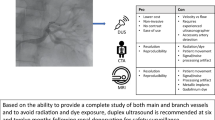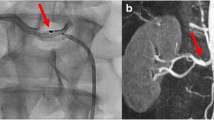Abstract
Optical coherence tomography (OCT) imaging at the time of renal denervation (RDN) showed that procedure might cause spasm, intimal injury or thrombus formation. In the present study, we assessed the healing of renal arteries after RDN using OCT and renal angiography in long-term follow-up. OCT and renal angiography were performed in 12 patients (22 arteries) 18.41 ± 5.83 months after RNS. There were no adverse events or complications during the long-term follow-up. In ten patients (83 %), significant reductions of blood pressure was achieved without a change of the antihypertensive medications. We demonstrated the presence of 26 areas of focal intimal thickening identified by OCT in 10 (83 %) patients and in 14 (63 %) arteries. The mean area of focal intimal thickening was 0.054 ± 0.033 mm2. No vessel dissection, thrombus, intimal tear or acute vasospasm were observed during the OCT analysis. Also, the quantitative angiography analysis revealed a significant reduction of the minimal and proximal lumen diameters at follow-up as compared to measurements obtained before RDN. Renal arteries have a favorable “long-term” vessel healing response after RDN. Focal intimal thickening and a modest reduction of the minimal lumen diameter may be observed after RF denervation. Further studies are needed to determine whether intravascular imaging may be helpful in evaluating the vessel healing of RF RDN.



Similar content being viewed by others
References
Krum H, Schlaich M, Whitbourn R et al (2009) Catheter-based renal sympathetic denervation for resistant hypertension: a multicentre safety and proof-of-principle cohort study. Lancet 373:1275–1281. doi:10.1016/S0140-6736(09)60566-3
Azizi M, Sapoval M, Gosse P et al (2015) Optimum and stepped care standardized antihypertensive treatment with or without renal denervation for resistant hypertension (DENERHTN): a multicentre, openlabel, randomized controlled trial. Lancet 385:1957–1965. doi:10.1016/S0140-6736(14)61942-5
Symplicity HTNI (2011) Catheter-based renal sympathetic denervation for resistant hypertension: durability of blood pressure reduction out to 24 months. Hypertension 57:911–917. doi:10.1161/HYPERTENSIONAHA.110.163014
Esler MD, Krum H, Schlaich M et al (2012) Renal sympathetic denervation for treatment of drugresistant hypertension: one-year results from the Symplicity HTN-2 randomized, controlled trial. Circulation 126:2976–2982. doi:10.1161/CIRCULATIONAHA.112.130880
Bhatt DL, Kandzari DE, O’Neill WW et al (2014) A controlled trial of renal denervation for resistant hypertension. N Engl J Med 370:1393–1401. doi:10.1056/NEJMoa1402670
Rippy MK, Zarins D, Barman NC et al (2011) Catheter-based renal sympathetic denervation: chronic preclinical evidence for renal artery safety. Clin Res Cardiol 100:1095–1101. doi:10.1007/s00392-011-0346-8
Templin C, Jaguszewski M, Ghadri JR et al (2013) Vascular lesions induced by renal nerve ablation as assessed by optical coherence tomography: pre- and post-procedural comparison with the Simplicity catheter system and the EnligHTN multi-electrode renal denervation catheter. Eur Heart J 34(2141–2148):2148b. doi:10.1093/eurheartj/eht141
Steigerwald K, Titova A, Malle C et al (2012) Morphological assessment of renal arteries after radiofrequency catheter-based sympathetic denervation in a porcine model. J Hypertens 30:2230–2239. doi:10.1097/HJH.0b013e32835821e5
Celik IE, Acar B, Kurtul A et al (2015) De Novo Renal Artery Stenosis After Renal Sympathetic Denervation. J Clin Hypertens (Greenwich) 17:242–243. doi:10.1111/jch.12482
Kaltenbach B, Id D, Franke JC et al (2012) Renal artery stenosis after renal sympathetic denervation. J Am Coll Cardiol 60:2694–2695. doi:10.1016/j.jacc.2012.09.027
Prati F, Jenkins MW, Di Giorgio A et al (2011) Intracoronary optical coherence tomography, basic theory and image acquisition techniques. Int J Cardiovasc Imaging 27:251–258. doi:10.1007/s10554-011-9798-1
Prati F, Regar E, Mintz GS et al (2010) Expert review document on methodology, terminology, and clinical applications of optical coherence tomography: physical principles, methodology of image acquisition, and clinical application for assessment of coronary arteries and atherosclerosis. Eur Heart J 31:401–415. doi:10.1093/eurheartj/ehp433
Kochman J, Tomaniak M, Koltowski L et al (2015) A 12-month angiographic and optical coherence tomography follow-up after bioresorbable vascular scaffold implantation in patients with ST-segment elevation myocardial infarction. Catheter Cardiovasc Interv 86:E180–E189. doi:10.1002/ccd.26006
Jaen Aguila F, Mediavilla Garcia JD, Molina Navarro E et al (2014) Bilateral renal artery stenosis after renal denervation. Hypertension 63:e126–e127. doi:10.1161/HYPERTENSIONAHA.113.03065
Hogestatt ED, Johansson O, Andersson KE et al (1988) Influence of renal denervation on vascular responsiveness of isolated rat intrarenal arteries. Acta Physiol Scand 132:59–66. doi:10.1111/j.1748-1716.1988.tb08298.x
Funding
This work was supported by European Union structural funds (Innovative Economy Operational Program POIG.01.01.02-00-109/09-00) and statutory funds of Medical University of Silesia.
Author information
Authors and Affiliations
Corresponding author
Ethics declarations
Conflict of interest
The authors declare that they have no conflict of interest.
Ethical approval
All procedures performed in studies involving human participants were following the ethical standards of the institutional and/or national research committee and with the 1964 Helsinki declaration and its later amendments or comparable ethical standards.
Informed consent
Informed consent was obtained from all individual participants included in the study.
Rights and permissions
About this article
Cite this article
Roleder, T., Skowerski, M., Wiecek, A. et al. Long-term follow-up of renal arteries after radio-frequency catheter-based denervation using optical coherence tomography and angiography. Int J Cardiovasc Imaging 32, 855–862 (2016). https://doi.org/10.1007/s10554-016-0853-9
Received:
Accepted:
Published:
Issue Date:
DOI: https://doi.org/10.1007/s10554-016-0853-9




